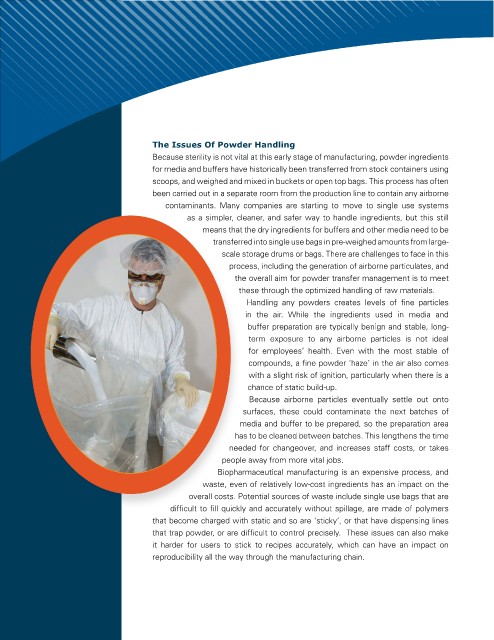Page 1692 - Flipbook_SolidDesignSoutheast2020
P. 1692
The Issues Of Powder Handling
Because sterility is not vital at this early stage of manufacturing, powder ingredients
for media and buffers have historically been transferred from stock containers using
scoops, and weighed and mixed in buckets or open top bags. This process has often
been carried out in a separate room from the production line to contain any airborne
contaminants. Many companies are starting to move to single use systems
as a simpler, cleaner, and safer way to handle ingredients, but this still
means that the dry ingredients for buffers and other media need to be
transferred into single use bags in pre-weighed amounts from large-
scale storage drums or bags. There are challenges to face in this
process, including the generation of airborne particulates, and
the overall aim for powder transfer management is to meet
these through the optimized handling of raw materials.
Handling any powders creates levels of fine particles
in the air. While the ingredients used in media and
buffer preparation are typically benign and stable, long-
term exposure to any airborne particles is not ideal
for employees’ health. Even with the most stable of
compounds, a fine powder ‘haze’ in the air also comes
with a slight risk of ignition, particularly when there is a
chance of static build-up.
Because airborne particles eventually settle out onto
surfaces, these could contaminate the next batches of
media and buffer to be prepared, so the preparation area
has to be cleaned between batches. This lengthens the time
needed for changeover, and increases staff costs, or takes
people away from more vital jobs.
Biopharmaceutical manufacturing is an expensive process, and
waste, even of relatively low-cost ingredients has an impact on the
overall costs. Potential sources of waste include single use bags that are
difficult to fill quickly and accurately without spillage, are made of polymers
that become charged with static and so are ‘sticky’, or that have dispensing lines
that trap powder, or are difficult to control precisely. These issues can also make
it harder for users to stick to recipes accurately, which can have an impact on
reproducibility all the way through the manufacturing chain.

